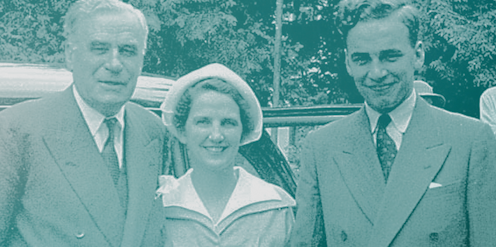
In September 1953, Rupert Murdoch arrived in sleepy Adelaide to take up his inheritance of News Limited. He was only 22 and had little experience of working at a newspaper, let alone running one, but his family had inherited a majority stake in the company following the death of Rupert’s father, the well-known journalist, editor and media executive Keith Murdoch.
After Rupert had completed his matriculation at Geelong Grammar in 1949 with marks that had not impressed his parents, he had worked briefly as a cadet reporter at the Melbourne Herald under his father’s watchful eye, spending a few months at the police courts with a friend from school before heading off to the United Kingdom.
Keith had accompanied him to London in early 1950 and introduced Rupert to leading figures in Fleet Street, helping his son land a summer stint as a junior reporter on the Birmingham Gazette – where Rupert made an impression when he told the proprietor the editor was so incompetent he should be sacked.
Rupert had then studied at Worcester College, Oxford. Again, he did not excel academically, but his contemporaries noticed he was financially astute and a shrewd problem-solver and risk-taker. Like Rupert Greene, his namesake grandfather on his mother’s side, Rupert dabbled in gambling and drinking beer more than his parents felt was good for him. And, like his father had been as a young man, Rupert was attracted to Labour politics. He famously kept a bust of Lenin in his room at Oxford.
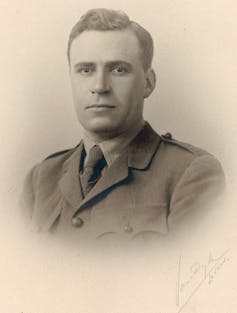
Keith tolerated Rupert’s excursion into left-wing politics and, in earlier years, had put him in touch with Labor prime minister Ben Chifley, who always replied courteously to Rupert’s letters. Keith told Chifley his 18-year-old son “is at present a zealous Laborite but will I think (probably) eventually travel the same course of his father”.
In the last months of his life, Keith was confident that Rupert was on the right track and would outgrow his socialist ideals. After finishing his studies at Oxford, Rupert worked on the subeditor’s desk at Lord Beaverbrook’s Daily Express, edited by the legendary Arthur Christiansen, considered one of Fleet Street’s greatest editors.
Christiansen was obsessed with detail and worked up to 18 hours a day for more than 20 years. His memorable instructions to staff were handed down through the ages, including his exhortation to “always, always tell the news through people”.
The Daily Express was chosen for Rupert because it was one of the toughest and most prestigious schools in journalism. Keith had personally asked Beaverbrook to arrange this work experience for his son and Rupert trained as a down-table sub (a junior subeditor).
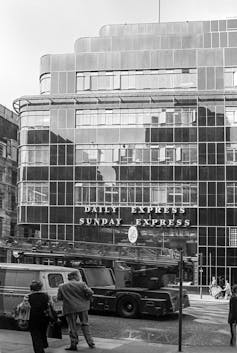
When Rupert took up the reins at News Limited, that was the extent of his experience – a few months each at the Herald, the Birmingham Gazette and the Daily Express, plus all he had picked up from his father’s shop talk at home and the detailed letters Keith sent Rupert during his school years.
As part of the grandeur surrounding his rise, it is often said that Rupert built an empire out of just one tired Adelaide newspaper. To be pedantic, that is not quite true. When he inherited a controlling interest in News Limited, it published the News (Adelaide’s afternoon newspaper), the (Sunday) Mail (also in Adelaide) and the Barrier Miner (in Broken Hill). It also had a large stake in Southdown Press, which was housed in West Melbourne and published the national women’s magazine New Idea.
The company also controlled radio station 2BH Broken Hill and had a minor holding in 5DN Adelaide. Certainly, it was a small company by comparison with the then giant of the media industry, the Herald and Weekly Times, but it was still a substantial start for a 22-year-old. It is true that the News was a tired and insignificant paper. It had a stagnant circulation and was drained of resources and revenue.
When Rupert arrived in Adelaide, he set about changing that and gave himself the unusual title of “publisher”. Old-timers raised their eyebrows and expected Rupert would sit in a corner at the News for a few years until he knew enough to contribute. They were misjudging him.
Rupert was a hands-on proprietor from the beginning. Editorially, he initially relied on, and gave a good deal of leeway to, Rohan Rivett, who had been editor of the News for almost two years.
Rupert and Rivett were already close friends because Keith had sent Rivett to report from London between 1949 and 1951, with a side instruction to keep an eye on the boss’s son. Rivett, the grandson of Alfred Deakin, had been a war correspondent, and for three and a half years a prisoner of war, including on the Burma–Thailand Railway.
From Keith’s perspective, Rivett had some radical views but he was satisfied that Rivett was no communist, and in the early 1950s he was a favourite Murdoch confidante. Rivett even named his son after Keith.
When Rupert arrived in Adelaide, Keith’s older protégé turned nemesis, Lloyd Dumas, chairman of the Advertiser, gave Rupert a memorable welcome by trying to push him out of business before Rupert even got started. On October 24 1953, the Advertiser launched the Sunday Advertiser.
It was designed to crush News Limited’s weekend paper, the Mail, which was the biggest-circulation paper in the state and a solid earner. The intention was to force Murdoch’s heirs to sell out so the Herald Weekly Times could reclaim the News. Dumas was a knight, a pillar of society in Adelaide, a city renowned for its “luminous and eccentric” establishment, its British-style manored estates, and blue-blood Adelaide Club members.
But Rupert showed immediately that he was not going to play by the usual rules of conduct, including the unwritten rule that newspaper owners did not publish stories about each other. A month after the Sunday Advertiser launched, Rupert’s Mail published a front-page story airing some industry dirty linen.
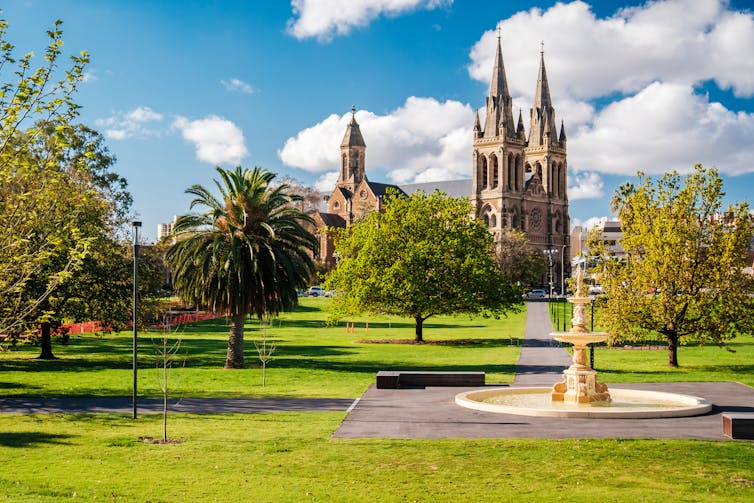
It reported that, after Keith Murdoch’s death, Dumas had gone to his widow, bound her to secrecy so she could not consult anyone, and told her to sell the family’s controlling stake in the company to him. When Elisabeth refused, he gave her an ultimatum: either sell him the Mail, or the Advertiser would start a new weekend paper and drive the Mail out of business. The article included excerpts from a private letter Dumas had sent to Elisabeth.
Dumas and Rupert fought a “nasty circulation war”. The challenger Sunday Advertiser was the better product but many of the Mail’s readers stayed loyal and it remained in front. As Adelaide was not large enough to support two Sunday papers, both companies bled money for nearly two years before the opponents called a truce and agreed to merge. Both took 50% of the newly merged Sunday Mail from December 1955. With no competition, it was very profitable. Rupert considered this co-venture a great victory and let it be known that Dumas had backed down.
Read more: The secret history of News Corp: a media empire built on spreading propaganda
Liberalism and sensationalism
Rupert let Rivett develop the News into the most liberal daily paper in the country, one with a social conscience that published very different views to the establishment Advertiser.
Murdoch learned all he could by working in various roles at the paper and developed a reputation for his overwhelming energy and for rolling up his sleeves and observing every phase of the production process. He was also becoming known for criticising and trying to make constant changes. One overwhelmed staff member called them “Rupertorial interruptions”.
Rivett focused on editorial while Murdoch focused on increasing advertising revenue, improving circulation, cutting costs and making production more efficient. Murdoch was particularly good at gaining retail and some new classified advertising for the News. News Limited’s profits jumped from $62,000 when he began in 1953, to $432,000 in 1959.
Murdoch had his eye on expansion immediately. His first move was to expand News Limited’s interest in magazine publisher Southdown Press. His next move, in October 1954, was to acquire Western Press Ltd, publisher of Western Australia’s only Sunday paper, the Sunday Times, in Perth. (It also owned a Saturday publication called the Mirror, and 20 country newspapers.)
The Sunday Times was where Murdoch honed his tabloid techniques. The paper was “tawdry” even before Murdoch bought it, but he made it more “sparkily so”.
Murdoch began flying to Perth every Friday to personally hammer the paper into a more sensational style to increase its sales. Murdoch biographer, Thomas Kiernan, said the Sunday Times was the birthplace of Murdoch journalism, “the exaggerated story filled with invented quotes; the slavishly sensationalised yarns; the eye-shattering, gratuitously blood-curdling headline”.
An infamous early one was “LEPER RAPES VIRGIN, GIVES BIRTH TO MONSTER BABY”. He also used competitions and zealous promotion to sell the paper. These became some of the other hallmarks of Murdoch’s tabloid approach.
The Sunday Times purchase was funded by a loan. Rupert’s new bank was the Commonwealth Bank in Sydney. It was then relatively small and had become a trading bank only in June 1953. Its general manager, Alfred Norman “Jack” Armstrong, and Vern Christie, who later became a managing director, thought Murdoch was a good risk, commercially savvy and always met his repayments.
The Commonwealth Bank’s willingness to lend Murdoch huge sums would prove crucial to the growth of his media empire.
Rupert stayed in Adelaide for seven years, from 1953 to 1960. Aside from newspaper production, he was also learning everything he could about radio and television, including on trips to the United States. It was a crucial turning point when Murdoch’s Southern Television Corporation Ltd (60% owned by News Limited) was granted one of two commercial television licences in Adelaide in 1958.
After a visit to the Philadelphia office of the popular US magazine TV Guide, Murdoch launched an Australian weekly television magazine. Southdown Press began publishing TV-Radio Week in December 1957, 14 months after Australian television had begun (it was called TV Week from 1958). Murdoch was also buying up small papers in remote towns across the country. He acquired the Cold War–born NT News and the Mount Isa Mail at the end of 1959.
Murdoch would fly into town in a DC-3 and haggle with the owner. Former News Limited executive Rodney Lever said:
His technique was simple: he would bully the owner into selling his paper with a threat that he would start a competing paper in the town.
Murdoch soon turned the NT News into a tri-weekly, and the Mount Isa Mail into a bi-weekly. By 1965, both were daily papers.
Read more: From irreverence to irrelevance: the rise and fall of the bad-tempered tabloids
Bold moves
Murdoch made two bold moves in Adelaide in 1958–59. One was political and the other commercial, and as journalist and author George Munster noted, these moves were not well coordinated; they ran in opposite directions.
The News took a strong stance on the trial of Rupert Max Stuart, an Indigenous carnival worker who had been convicted in 1958 of the rape and murder of a nine-year-old girl.
After a confession to police over which there hung significant doubt, Stuart was sentenced to death and his conviction was upheld by the Supreme Court of South Australia. Rivett was convinced Stuart had not had a fair trial and the News campaigned fiercely for the case to be reopened. The paper’s attacks on authorities in South Australia’s police force and courts were the talk of the city.
Murdoch supported Rivett “wholeheartedly” and saw the case as a way to attack both the Adelaide establishment and the conservative Playford government, which had been in office since 1938 as the beneficiary of a ruthlessly gerrymandered election system.
Labor politician Clyde Cameron, who was dining and socialising with Murdoch at this time, found Rupert “was much further Left than me”. When the case was at its height, Murdoch said to him:
I’m in a spot, Clyde. Myers [sic] have phoned to say that unless we drop our campaign in favour of Stuart, they are going to withdraw all of their advertising from the News and that means a lot to us … I told them to go to hell.
Playford was forced to set up a Royal Commission to examine the Stuart case and the News ran fierce attacks on it too, including lambasting royal commissioners for improperly sitting in judgement of their own earlier decisions. The News’ coverage landed Rivett, Murdoch and other employees in court on a string of charges, including the archaic, rarely used charge of seditious libel, which could have seen them imprisoned.
Rupert was said to be deeply shaken by the potential risks and how far matters escalated. Eventually, the charges were dismissed and the News ran an editorial apologising and disavowing criticism of the judiciary members. There was speculation that Playford had dropped the charges in return for the News halting its campaign against his government.
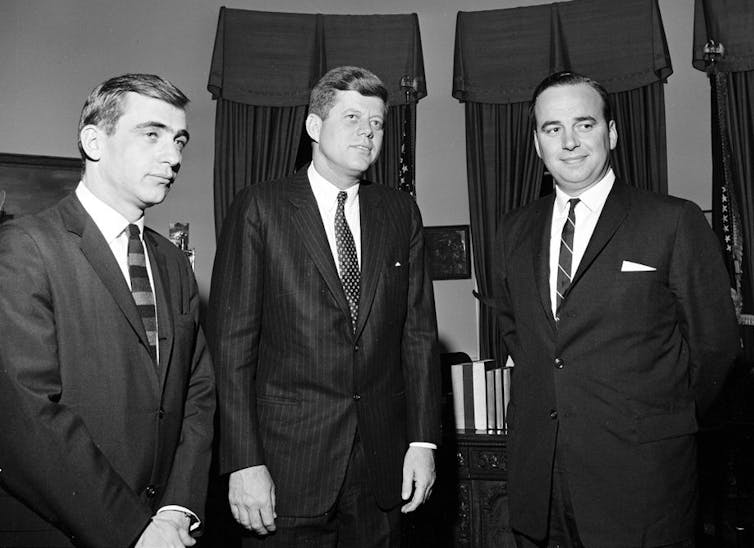
An old friend sacked
While the Adelaide establishment was still buzzing about the Stuart case, Murdoch made an audacious bid to gain control of the Advertiser. Backed by the Commonwealth Bank, Murdoch made an offer of more than £14 million in shares and cash to Advertiser Newspapers Ltd. At a time when News Limited had less than £1.8 million in shareholders’ funds, it was one of the biggest corporate takeover bids in Australian history.
Dumas quashed the bid. The Advertiser announced in its pages that its board rejected the takeover bid and Dumas announced that the holders of more than 50% of Advertiser shares refused to accept Murdoch’s offer.
Dumas added tartly that the South Australian community and the paper’s shareholders have a “real pride in the Advertiser and would never agree to its being modelled on the News”, nor let Murdoch, as head of Cruden Investments, “a Victorian company”, exercise “complete individual control” over the Advertiser as he did with the News.
The Herald Weekly Times’ old hands had blocked Murdoch but he had made a strong impression and provided a bold declaration of his ambitions. He had also shown the business world he could muster significant capital and it was becoming obvious he would not easily be bought or driven out.
Five weeks after the last charges over the Stuart Royal Commission were withdrawn, Murdoch wrote a curt note from Sydney that “summarily dismissed” Rivett as editor.
This was a man Murdoch had considered “like the brother he never had”. Some speculated that Rivett’s sacking may have been part of the deal with Playford. Others believed it was inevitable because Murdoch was asserting himself more and his priorities were changing. Either way, it was strong evidence that Murdoch was not going to let friendship get in the way of business.
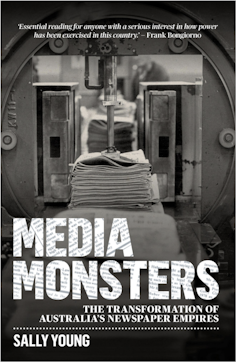
The Stuart case had happened at a formative time for Murdoch, when his political views were still developing. Back in 1953, with a state election imminent in South Australia, he had written to Rivett, “I implore you not to speak out too loudly on either side.”
Personally, Rupert had strong views on Robert Menzies though. He was said to loathe the prime minister because he was part of the Melbourne business establishment that had rejected him after his father’s death. Menzies had essentially chosen Jack Williams at the Herald and Weekly Times over Murdoch. Murdoch also thought Menzies was holding Australia – and himself – back.
In 1958–59, Murdoch had tried taking on the establishment in Adelaide by bringing on a showdown with the premier and the Adelaide Club, but had to back down. The experience seemed to chasten him and turn him away from advocacy journalism for the moment, and toward safer forms that did not clash with his commercial goals.
This is an edited extract from Media Monsters: The Transformation of Australia’s Newspaper Empires by Sally Young (New South Publishing).
Sally Young received funding from the Australian Research Council (ARC) future fellowship scheme to study newspaper history and press power. Since 2019, she has been a research committee member of the Centre for Public Integrity which conducts research aimed at strengthening Australian democracy.
This article was originally published on The Conversation. Read the original article.







